Production in Bags
Substrate preparation. In the United States, the primary ingredients used for Pleurotus spp. production are chopped wheat straw (Triticum aestivum L) or cottonseed hulls (Gossypium hirsutum L) or mixtures of both. For production on wheat straw, the material is milled to a length of about 2 to 6 cm. Production of Pleurotus spp. on cottonseed hulls has some advantages over straw-based production systems in that chopping of the hulls is not required. One of the most common substrates used on modern mushroom farms is a mixture of 75 percent cottonseed hulls, 24 percent wheat straw, and 1 percent ground limestone. This mixture of cottonseed hulls and wheat straw has a higher water holding capacity than cottonseed hulls used alone. At Penn State’s Mushroom Research Center (MRC), a large-capacity, scale-mounted feed mixer (Figure 1) is used to simultaneously grind and mix the material as water is added to increase the moisture content to 67 to 69 percent.
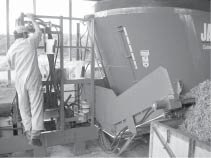
Figure 1. A large-capacity, scale-mounted feed mixer is used
at the Mushroom Research Center (MRC) to process Pleurotus spp. mushroom substrates
for filling into pasteurization containers.
Pasteurization. On some commercial mushroom farms, ingredients are fed into revolving mixers, water is added to the desired level, and live steam is injected into the mixer while in operation. At the MRC, moistened, mixed substrate is filled into galvanized metal boxes with perforated floors (Figure 2). The substrate is pasteurized with aerated steam at 65oC for 1 hour by passing the air-steam mixture through the substrate from top to bottom. After pasteurization is complete, filtered air (HEPA filter, 99.9 percent efficiency) is passed through the substrate for cooling (approximately 1.5 hours).
Spawning and spawn rate. Growers have sought, in the past, to optimize the amount of spawn used to inoculate their substrate. Increasing the amount of spawn used (up to 5 percent of the wet weight of the substrate) has resulted in increased yields. Increasing spawn rates from 1.25 percent substrate wet weight to 5 percent may result in yield increases of nearly 50 percent (Figure 3a). Yield increases may be due to several factors. First, the increased level of nutrient available in higher levels of spawn used would provide more energy for mycelial growth and development. Second, more inoculum points, available from increased spawn levels, would provide faster substrate colonization and thus, more rapid completion of the production cycle. Finally, a more rapid spawn run would reduce the time non-colonized substrate is exposed to competitors such as weed molds and bacteria.
Figure 2. Steam boxes (A) with perforated floor (B) used for filling ©
and aerated-steam pasteurization (D) of Pleurotus spp. mushroom substrate.
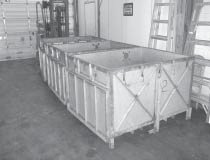
Fig.2a
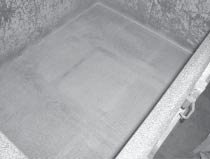
Fig.2b
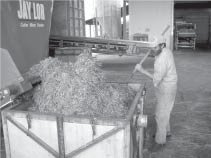
Fig.2c
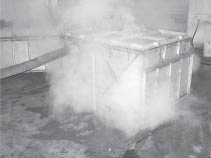
Fig.2d
For increasing levels of spawn used (up to 5 percent), there is a negative correlation between spawn rate and days to production. As the spawn rate increases, the number of days to production decreases (Figure 3b). By using a spawn rate of 5 percent of the wet substrate weight, it is possible to reduce the time to production by more than 7 days compared to a spawn rate of 1.25 percent. Thus, growers could complete the crop cycle faster, minimizing the exposure of the production substrate to pest infestations, especially sciarid (Lycoriella mali [Fitch]) flies. Research has shown that the sciard fly may complete its life cycle in 25 days at 21°C, while 35 to 38 days are required at 18°C. Timely disposal of spent substrate may help to minimize the buildup of fly populations on a mushroom farm.
Figure 3. Influence of four spawn rates (1.25, 2.5, 3.75 and 5 percent of substrate wet weight)
on Pleurotus cornucopiae mushroom yield (A) and days to production (B).
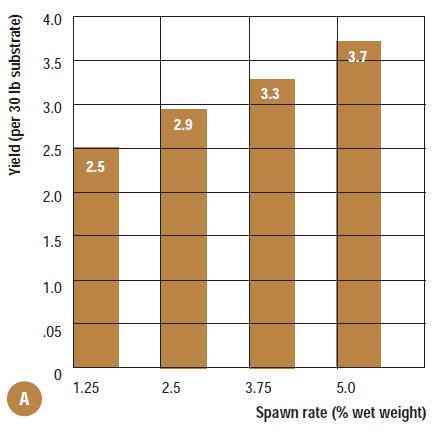
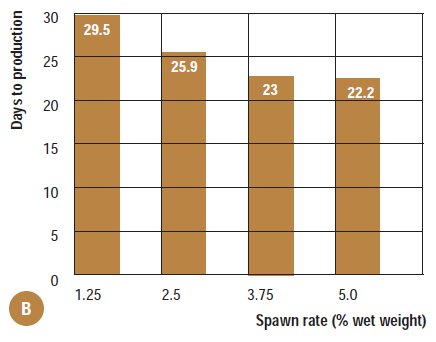
Use of delayed-release supplements. At time of spawning, a commercial delayed release supplement consisting of paraffin-coated whole soybean or formaldehyde-denatured soybean and feather meal may be added at rates of 3 to 6 percent of dry substrate weight, to stimulate yield of the mushroom. Yield increases of up to 90 percent have been observed when 6 percent (dry weight) supplement is added to substrate at time of spawning (Figure 4a). Delayed-release nutrient supplements have also been shown to decrease the number of days to harvest (Figure 4b). The addition of 3 percent nutrient at time of spawning may reduce time to production by 2 to 3 days. Thus, growers wishing to hasten the production process may do so by supplementing with only small quantities of supplement. Use of supplements, however, may cause overheating of the substrate if growers are unable to anticipate and control air temperatures to maintain a steady substrate temperature. Additional cooling capacity is required when higher levels of supplement are used.
Figure 4. Influence of three delayed-release supplement rates
(0, 3, and 6 percent of substrate dry weight)
on mushroom yield (A) and days to production (B).
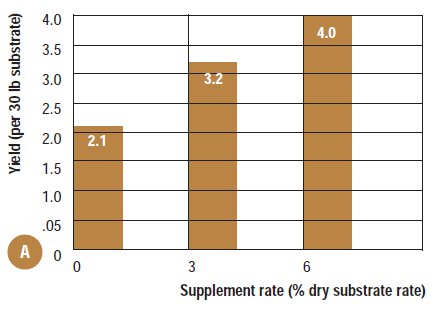
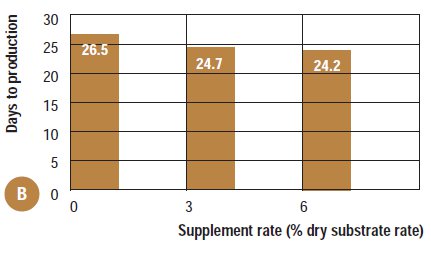
Filling plastic bags with substrate. The pasteurized, supplemented hull/straw mixture is spawned and filled (25 to 30 pounds) into clear or black perforated polyethylene bags and then incubated at 23° to 25°C (substrate temperature) for 12 to 14 days. Mushrooms then begin to form around the edges of bag perforations and they are harvested from the substrate approximately 3 to 4 weeks after spawning depending on strain, amount of supplement used, and temperature of spawn run (Figure 5).
Figure 5. Yellow oyster mushrooms (Pleurotus cornucopiae) fruiting from pasteurized substrate
(75 percent cottonseed hulls, 24 percent chopped wheat straw, and 1 percent ground limestone)
contained in black bags suspended from overhead supports (MRC).
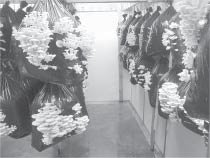
5605 view.